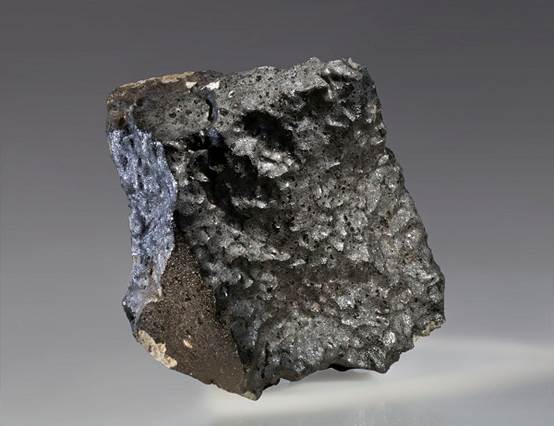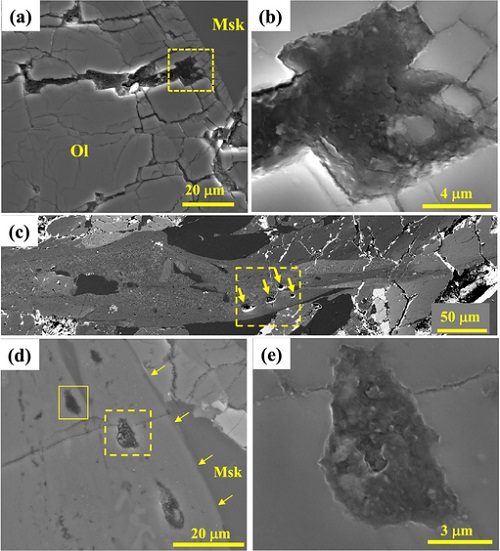In addition to our home Planet, Earth, life was probably present on Mars. Evidence from the exploration of Mars, which includes topographic features and the presence of aqueous alteration minerals and sulfates, suggests the existence of liquid water, even oceans, on the surface of Mars, which is essential for life. The detection of methane (30 ppb) in the Martian atmosphere by the Mars Express orbiter in 2004 has further inspired Martian exploration. The Mars rover Curiosity, more than two billion dollars in value, has successfully land on Mars with the goal of investigating the paleoenvironment and paleoclimate of Mars, and eventually detecting the sign of biotic activity on Mars. Another approach is to analyze Martian meteorites in laboratories. To-date, the number of record Martian meteorites is more than 120. The Tissint meteorite is the fifth witnessed fall of a Martian meteorite and fell in July 2011 in the Moroccan desert. This meteorite supplies us with uniquely fresh samples to search for traces of biotic activities on Mars and to study Martian paleoenvironment suitability for life (Fig 1).

Fig 1. The Tissint Martian meteorite
Professor Yangting Lin and his team, Institute of Geology and Geophysics, Chinese Academy of Sciences (IGGCAS), cooperating with scientists from the Institute of Geochemistry, CAS, Guangzhou Institute of Geochemistry, CAS, National Astronomical Observatories, CAS, and Universität Bayreuth, EPFL, Tohoku University, found carbon grains in the Tissint Martian meteorite. Using microscopic analysis techniques, which included NanoSIMS and Laser Raman spectrometer at IGGCAS, they obtained Laser-Raman spectra, high-resolution elemental distribution images and H, C, N isotopic compositions of these carbon grains. The laser-Raman spectra and NanoSIMS analyses indicate these carbonaceous components are kerogen-like organic carbon, similar to coal. The authors assert that the organic matter that they found in Tissint is pristine and is not terrestrial contamination. This has been confirmed by the following lines of evidence: (1) it is deuterium-enriched (up to +1183‰), a stark diagnostic feature distinguishing Martian materials from terrestrial contamination; (2) the presence of organic matter inclusions capsulated in shock-induced melt veins indicates its formation predated the shock event of the melt veins; (3) partial conversion of the organic carbon inclusions entrained in the shock-melt veins to diamond also points to strong impact events, which must have occurred on Mars; (4) the organic matter present in Tissint is insoluble in both water and acetone. It is also unlikely that local organic matter in the Moroccan desert could have been deposited in the interior fractures of the meteorite within a few months after its fall. Finally, NanoSIMS analysis of the organic matter shows significant 13C-depletions (δ13C = -12.8 ‰~-33.1 ‰) relative to Martian atmospheric CO2 (δ13C = -2.5
 ~+46 ‰) and carbonates, consistent with a biogenic origin. The N isotopes of organic compound are normal, suggestive of a possible origin from Martian soil instead of Martian atmosphere.
~+46 ‰) and carbonates, consistent with a biogenic origin. The N isotopes of organic compound are normal, suggestive of a possible origin from Martian soil instead of Martian atmosphere.

Fig 2. SEM images of the organic carbon in Tissint. (a-b) Dark organic carbon fills all of the fractures and cleavages in olivine (Ol); (c-e) organic matter inclusions in a shock-melt vein.

Fig 3. Carbon isotopic composition of the organic matter in Tissint. These organic matter are significantly lighter than the Martian Atmospheric CO2 and carbonate in Martian meteorite, but similar to the terrestrial organic materials.
Based on the experimental data, the authors propose the following formational scenario. (1) The host rock of Tissint was formed about 600 million years ago via eruption of a basaltic magma into the subsurface of Mars. (2) After solidification and a period of residence near the surface of Mars, the igneous rock was impacted by an asteroid, which highly fractured the rock and converted crystal of plagioclase to glass (namely maskelynite). (3) Sometime after this impact event, the Tissint host rock was infiltrated by organic-rich fluids that led to the deposition of organic matter in the shock-induced fractures and cleavages. (4) Following deposition of the organic matter in fracture spaces, another impact partially melted the organic-bearing host rock and produced the shock-melt veins with organic carbon inclusions. (5) Finally, a third asteroid impacted the igneous rock, launching Tissint into an Earth-crossing orbit, and then fell on the Moroccan desert.
This study has published as cover article in December 2014 in the international journal of Meteoritics & Planetary Science(Lin et al. NanoSIMS analysis of organic carbon from the Tissint Martian meteorite: Evidence for the past existence of subsurface organic-bearing fluids on Mars. Meteoritics & Planetary Science, 2014, 49(12): 2201-2218)Link